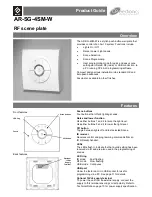
N2HET Functional Description
798
SPNU503C – March 2018
Copyright © 2018, Texas Instruments Incorporated
High-End Timer (N2HET) Module
20.2.2.1 N2HET RAM Banking
Because the CPU must make updates to the N2HET RAM while the N2HET is executing, for example to
update the duty cycle value of a PWM, it is important to understand how the N2HET RAM organization
facilitates simultaneous accesses by both the HOST CPU and the N2HET.
The N2HET RAM is implemented as 4 banks of 96-bit wide two port RAM. This means that there a total of
8 ports available; four read and four write. Normally the N2HET will use up to two of these ports at a time.
One read port is used to allow the N2HET to prefetch the next N2HET instruction while a write port may
be used to update the data or control fields that have changed as a result of executing the current
instruction.
N2HET accesses to its own internal RAM are given priority over accesses from an external host (CPU or
DMA), this makes N2HET program execution deterministic which is a critical requirement for a timer.
Most N2HET instructions execute in a single cycle. Cases where a wait state impacts the N2HET program
execution time are:
•
The current N2HET instruction writes data back to the next N2HET in the execution sequence.
•
The external host reads from an N2HET instruction where the automatic read-clear option is set, while
the N2HET is executing from/on the same address (See
).
Except for the case of automatic read-clear, the external host is stalled when the host and N2HET have a
bank conflict. However this will typically only result in a stall of one cycle, due to the N2HET bank ordering
which is organized on the N2HET Address least significant bit boundaries (See
Assuming most of the N2HET program executes linearly through the N2HET Address space; if a bank
conflict does exist it is usually resolved in the next cycle as the N2HET program moves to the next bank.
N2HET programmers should avoid writing a program that accesses the same bank of N2HET RAM on
every cycle, as this could lock the external host out of the N2HET memory completely.
describes the N2HET memory map, as viewed by the N2HET as well as from the memory
space of the host CPU and DMA.
Table 20-2. N2HET RAM Bank Structure
N2HET Address
Host CPU or DMA Address Space
Instruction
Program Field
Address
Control Field
Address
Data Field
Address
Reserved
Address
N2HET RAM
Bank
000h
XX0000h
XX0004h
XX0008h
XX000Ch
A
001h
XX0010h
XX0014h
XX0018h
XX001Ch
B
002h
XX0020h
XX0024h
XX0028h
XX002Ch
C
003h
XX0030h
XX0034h
XX0038h
XX003Ch
D
004h
XX0040h
XX0044h
XX0048h
XX004Ch
A
:
:
:
:
:
:
03Fh
XX03F0h
XX03F4h
XX03F8h
XX03FCh
D
040h
XX0400h
XX0404h
XX0408h
XX040Ch
A
:
:
:
:
:
:
1FFh
XX1FF0h
XX1FF4h
XX1FF8h
XX1FFCh
D
NOTE:
The external host interface supports any access size for reads, but only 32-bit writes to the
N2HET RAM are supported. Reserved addresses should not be accessed, the result of
doing so is indeterminate.
















































